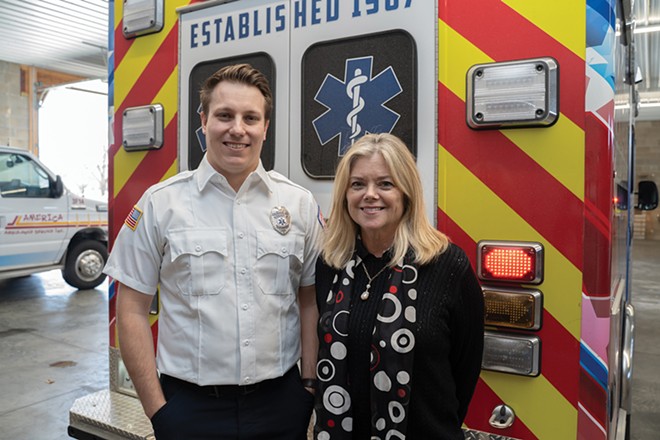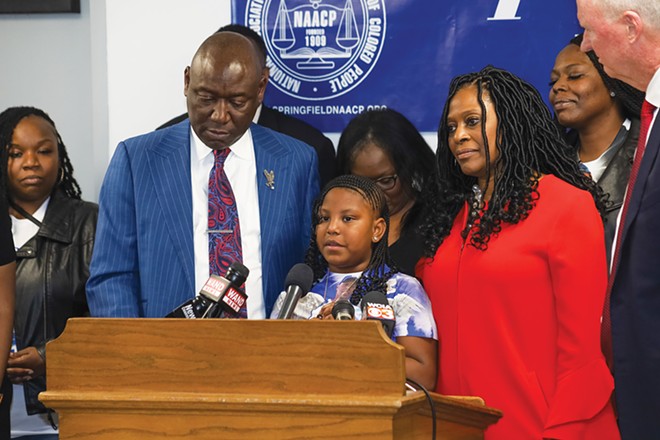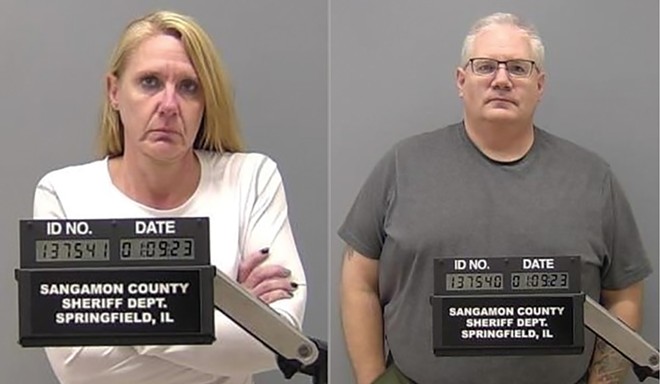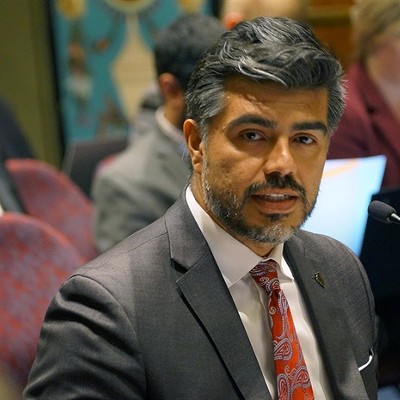Poor people and Black people who live in the Springfield area have told Teresa Haley they will be "more cautious" in the future after calling 911 in medical emergencies.
Haley, who is president of the Springfield NAACP chapter and the group's statewide leader, said she is glad if residents are more vigilant and willing to speak up or refuse care if they detect a lack of respect or rough treatment from emergency medical services workers.
Haley said she would rather promote caution and skepticism than see more needless suffering. "We want our community to call for help when they need help," she said.
The added assertiveness is only one ramification of the Dec. 18 early morning death of Springfield resident Earl Moore Jr. Ruled a homicide from "compressional and positional asphyxia" at the hands of two white LifeStar Ambulance Service workers, the death of Moore, 35, a Black McDonald's shift manager, has put a nationwide spotlight on Springfield in terms of racial disparities and EMS care.
The tragedy resulted in first-degree murder charges against LifeStar paramedic Peggy Finley, 45, and emergency medical technician Peter Cadigan, 50, and made police body camera videos of the incident go viral.
The videos showed what some characterized as rude and insensitive treatment and Moore's placement on a LifeStar ambulance gurney face-down, or prone, position by Cadigan, contrary to medical recommendations and local policies that either discourage or prohibit the prone position because of the risk of suffocation. Moore was pronounced dead soon after being transported to HSHS St. John's Hospital.
The case attracted civil rights lawyer Ben Crump, who was contacted by Moore's family and filed a wrongful death lawsuit against the workers and LifeStar on behalf of the family. Crump said the Moore case may be the first such homicide in the United States allegedly caused by EMS workers.

Even before the criminal and civil cases are resolved, a change in Springfield EMS procedures directly tied to the case is likely to take effect.
And local officials already are reacting to a bill introduced in the General Assembly by state Sen. Doris Turner, a Springfield Democrat, to require that all EMS workers in Illinois wear body cameras.
The case also dovetails with an ongoing examination of the area's EMS system and a recently completed analysis of fire department operations by the nonprofit Center for Public Safety Management. The report said city code contains "no provisions for performance evaluations, metric reporting, cost sharing or any other requirements" for LifeStar and the other two private ambulance services transporting Springfield residents to hospitals – America Ambulance and nonprofit MedicsFirst.
The three services are overseen by Springfield-based Memorial Health, the nonprofit health system that operates the 500-bed Springfield Memorial Hospital and hospitals in Jacksonville, Taylorville, Lincoln and Decatur. Memorial Health is part of Illinois' decentralized system of "resource hospitals" that provide training and oversight to ambulance providers.
But as a nonprofit, Memorial is not subject to the Illinois Freedom of Information Act or Open Meetings Act. HSHS St. John's Hospital, also a nonprofit, oversees other ambulance providers in the region, including those operated by the Chatham Fire Protection District, Pawnee and Litchfield fire departments and Dunn's Ambulance Service in Taylorville.
One downstate EMS source, who asked not to be named because he still works in the industry, said EMS workers who are fired by one employer often have few problems being hired by another because of a staffing shortage, and resource hospitals can be reticent to report bad workers to the state.
The Illinois Department of Public Health, which has the power to fine and impose other sanctions on EMS providers and resource hospitals, didn't respond to repeated requests for interviews by press time.
IDPH also didn't answer written questions about how residents can be assured there is adequate state regulation of an EMS system overseen by private, nonprofit hospitals that don't have to answer questions from the public about the quality and training of paramedics, EMTs and ambulance services.
Both Memorial and St. John's declined interview requests from Illinois Times for this story. LifeStar has declined comment in the past, and both LifeStar and MedicsFirst didn't respond to recent interview requests. Only America Ambulance spoke up.
New emergency response protocol Springfield Police Chief Kenneth Scarlette and Fire Chief Brandon Blough are working with the 911 dispatch center, operated by Sangamon County government, to test out a new policy in which fire department paramedics and EMTs may be dispatched to accompany private ambulance crews whenever police call for an ambulance.

As sometimes occurs, only an ambulance crew was dispatched after police called for medical help from Moore's home shortly after 2 a.m. Dec. 18 in the 1100 block of North 11th Street.
Police – rather than ambulance and fire department crews – were the first to be dispatched to the home because Moore called 911 and incorrectly told a 911 operator that there were people inside his home with guns, Scarlette said.
In reality, Moore was hallucinating during withdrawal from alcohol, police said.
Scarlette said the new policy will take effect in the next month or two and last for at least three to six months to gauge how much strain it puts on fire department resources. The change could be made permanent after that.
"To me, that adds just one level of oversight for patient care," Scarlette said. "If there's anything to be gained from this tragedy, it's to prevent it from happening again."
Added Blough, "I've given my blessing that we are willing to do this in the short term."
Springfield firefighters, all of whom are certified as EMTs or paramedics, drive fire trucks or engines and provide care associated with more than 13,500 EMS calls each year, representing more than 60% of all requests to the fire department for help, Blough said.
EMS calls to the fire department in 2022 represented an 8.5% increase compared with 2021, he said.
Fire personnel routinely are dispatched with ambulance services to EMS calls when police aren't involved, and firefighters often get to the scene first because of their proximity in 12 firehouses throughout the city, Blough said.
It's unclear how often ambulances respond alongside firefighters or on their own when Springfield police call for medical aid, according to Blough and Christopher Mueller, 911 center executive director.
The fire department and ambulances also handle EMS and fire calls in the pocket communities surrounded by Springfield, including Jerome, Leland Grove, Grandview and Southern View.
The fire chief said that the way Earl Moore was allegedly treated was an "anomaly" in his more than 20 years with the fire department.
"The level of field care that people get in Springfield is really good," Blough said. "I've been on hundreds, if not thousands, of medical scenes during the course of my career and never seen anything like this. ... This was an outlier. This is not how our private ambulance companies generally perform."
However, Blough said that if fire department personnel were present Dec. 18, "our people would not have put Mr. Moore face-down on that cot. And if they saw it happen, they would have rectified it. That probably would have made all the difference in the world."

Scarlette said Springfield police will receive additional basic training on emergency medical procedures in coming weeks to give them more confidence to question EMS providers if they witness care that worries them.
Haley said she supports sending fire personnel along with private ambulances when police are the ones initiating the call. "Had that happened, I believe Earl would still be here," she said.
Haley said EMS workers in central Illinois have told her this isn't the first time a Black patient has received less-than-respectful treatment, though this may be the first time the situation ended in death.
Challenges faced by EMS
Officials at Springfield's Southern Illinois University School of Medicine said in a statement Jan. 17 they fear "the trauma experienced by people in our community as they hear of this tragedy and watch the bodycam footage will erode trust and likely challenge the progress that has been made" in improving relationships with "those who have been historically marginalized, displaced and oppressed by health systems and health care organizations."
Robert Bajier, director of operations for America Ambulance, which employs about 70 people and is the largest ambulance provider in Springfield, said the alleged conduct of ambulance workers in the Moore case is unusual and "a poor representation of EMS."
"We don't agree with some of the things that happened during that call," he said.
America Ambulance owner and president, Susan Zappa, said the actions of "poor providers" in the Moore case threaten to undermine trust in EMS providers. "That's the sad thing," she said.
The Moore case is only the latest challenge facing EMS locally and nationally. Enrollment at the EMS training program at Lincoln Land Community College dropped during the COVID-19 pandemic. And there's a "significant and profound" shortage of ambulance personnel due to local and national issues related to pay and working conditions, according to Trevor Smith, director of the EMS program at Richland Community College in Decatur.
Officials at Lincoln Land, including those in the president's office, public relations and the emergency medical services program, either didn't return calls and emails or refused to be interviewed.
The threat of contracting COVID-19 scared some students away from the Lincoln Land program, Bajier said, though numbers have risen more recently with help from Memorial Health, HSHS and SIU.
Memorial Health donated $6.1 million to the community college to expand slots in Lincoln Land's nurse training program and renovate the wing of a campus building for a new Nursing Education Center that opened in 2021. Both Memorial and St. John's officials sit on the college's EMS program advisory board.
A Lincoln Land student can become a basic EMT after one semester of instruction, but becoming a paramedic, who is allowed to perform more medical procedures, requires two years of "intense work," Bajier said.
The dropout rate in paramedic training programs is high because of the difficulty, he said. And many people who become EMTs don't end up working for ambulance providers and instead use the training as a step toward becoming a nursing technician, registered nurse or physician, he said.
Many EMTs and paramedics who end up staffing ambulance services enjoy the autonomy, the excitement and the ability to help people outside the walls of a hospital, Smith said.
But it can be difficult to attract and retain people in the field because of pay – a national average of $20 per hour for paramedics and salaries close to the minimum wage for EMTs – as well as a lack of upward mobility, Smith said.
Bajier said America's pay ends up being higher than that when built-in overtime is included. Average annual pay for America paramedics ranges from $60,000 to $80,000, and average pay for EMTs ranges from $50,000 to $70,000 per year, he said.
The 2022 national survey by the National Association of EMTs indicated the COVID-19 pandemic "further exacerbated" an exodus of workers from EMS and increased the annual turnover rate to as high as 20% to 30%.
The survey reported 77% of EMTs make less than $40,000 per year and 68% of paramedics make between $42,000 and $80,000 per year.
The survey said it's common for EMS practitioners to work more than one job. Sixty percent said they worked two or more jobs: 34% held a second job in EMS, and 26% worked a second job in another industry.
EMS working conditions can be challenging, with paramedics and EMTs working 24-hour shifts with 48 hours in between shifts, Smith said. Other difficulties include inclement weather, the need to lift increasingly obese patients, and rising call volumes connected with the aging of the population and patients who use 911 as their primary form of health care, he said.
The national survey indicated 45% of respondents planned to leave the profession within six years. Of those, 47% said they would leave for better pay and benefits, and 50% said they were leaving for a better work-life balance.
Zappa said ambulance services face financial challenges, as well. Reimbursements from Medicare and Medicaid aren't generous, and ambulance companies aren't paid for services they render in the community when patients aren't brought to the hospital, she said. Ambulance providers also receive little or no pay from uninsured patients, she said.
Arthur Workman, executive director of the Illinois EMS Association, declined an interview request but wrote in response to questions about the Moore case: "We do not feel that this case represents proper patient care, basic decency, nor proper protocol when it comes to patient handling and scene assessment. EMS, as an industry, is struggling with crisis-level staffing challenges that are pushing the demand on EMS providers beyond limits, with individuals working longer shifts, facing massive burnout, and facing challenges beyond those that other industries face. This is not an excuse for what happened, and we hope the public sees that this is not a representation of EMS in Illinois."
Body camera bill proposed
State Sen. Doris Turner said her bill, requiring body cameras for EMS workers and dashboard cameras for ambulances, is designed to prevent more cases such as Moore's, though she said she has no idea whether the way Moore allegedly was treated is common.
"Had it not been for the body cameras that the police were wearing at the time, we would never know what actually took place during that interaction with the emergency personnel," she said.
Turner said she was involved in getting body cameras for police officers when she served on the Springfield City Council. Body cameras for police across the state will be required by 2025. Springfield police began wearing body cameras in 2016.
Turner said she didn't know how much the purchase of body cameras, video storage capacity and related services would cost EMS agencies and fire departments throughout the state or how the cost would be paid. It's still early in the legislative process, she said.
Senate Bill 1306 says EMS body camera recordings would be exempt from disclosure except when they are requested by the person who made the service call, the person's attorney or personal representative, or a law enforcement official.
Several EMS officials said the bill may be a good idea, but they had concerns related to cost and preserving patient privacy.
But Haley said she supports the proposal and wants to see it expand to a national requirement for EMS.
"We believe that bodycams save lives," she said.
Smith, the EMS training program director at Richland Community College, said he hopes the attention EMS is receiving because of the Moore case will have a "positive impact on our profession. We need to be truthful. We take care of patients at their most vulnerable times."
Dean Olsen is a senior staff writer at Illinois Times. He can be reached at [email protected], 217-679-7810 or twitter.com/DeanOlsenIT.



















